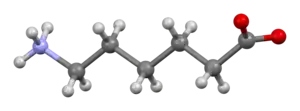Aminocaproic acid
 Skeletal formula | |
 | |
| Names | |
|---|---|
| Trade names | Amicar |
| Other names | ε-aminocaproic acid, ε-Ahx |
IUPAC name
| |
| Clinical data | |
| Main uses | Certain bleeding disorders[3] |
| Side effects | Nausea, abdominal pain, diarrhea, dizziness, fever, shortness of breath, headache, swelling, itchiness[4] |
| WHO AWaRe | UnlinkedWikibase error: ⧼unlinkedwikibase-error-statements-entity-not-set⧽ |
| Pregnancy category |
|
| Routes of use | By mouth, intravenous |
| External links | |
| AHFS/Drugs.com | Monograph |
| MedlinePlus | a608023 |
| Legal | |
| License data | |
| Legal status | |
| Pharmacokinetics | |
| Metabolism | Kidney |
| Elimination half-life | 2 hours |
| Chemical and physical data | |
| Formula | C6H13NO2 |
| Molar mass | 131.175 g·mol−1 |
| 3D model (JSmol) | |
| Melting point | 205 °C (401 °F) |
SMILES
| |
InChI
| |
Aminocaproic acid, sold under the brand name Amicar among others, is a medication used to treat certain bleeding disorders.[3] This may include bleeding due to fibrinolysis such as may occur following heart surgery, abruptio placentae, liver cirrhosis, and in cancer; bleeding within the eye; and hereditary hemorrhagic telangiectasia.[3][4] It may be taken by mouth or injection into a vein.[4]
Common side effects include nausea, abdominal pain, diarrhea, dizziness, fever, shortness of breath, headache, swelling, and itchiness.[4] Other side effects may include muscle breakdown.[4] It should generally not be used in people with bleeding from within the kidney.[4] Safety in pregnancy is unclear.[4] It is a form of carboxylic acid that decreases fibrinolysis.[4]
Aminocaproic acid was approved for medical use in the United States in 1964.[4] It is available as a generic medication.[6] In the United States 15 pills of 500 mg costs about 44 USD as of 2022.[6]
Medical use
Aminocaproic acid is used to treat acute bleeding due to elevated fibrinolytic activity.[3] It also carries an orphan drug designation from the FDA for the prevention of recurrent hemorrhage in patients with traumatic hyphema.[7] In clinical practice, aminocaproic acid is frequently used off-label for control of bleeding in patients with severe thrombocytopenia,[8] control of oral bleeding in patients with congenital and acquired coagulation disorders,[9] control of perioperative bleeding associated with cardiac surgery,[10][11] prevention of excessive bleeding in patients on anticoagulation therapy undergoing invasive dental procedures,[12] and reduction of the risk of catastrophic hemorrhage in patients with acute promyelocytic leukemia.[13]
Society and culture
Aminocaproic acid is also an intermediate in the polymerization of Nylon-6, where it is formed by ring-opening hydrolysis of caprolactam. The crystal structure determination showed that the 6-aminohexanoic acid is present as a salt, at least in the solid state.[14]
References
- ↑ G. J. Reiss (2010). "CSD Communication AMCAPR11: 6-Aminohexanoic acid". Cambridge Structural Database: Access Structures. Cambridge Crystallographic Data Centre. doi:10.5517/ccv38nv. Archived from the original on 2021-11-04. Retrieved 2021-08-18.
- ↑ Bodor, Géza; Bednowitz, Allan L.; Post, Ben (1967). "The crystal structure of ε-aminocaproic acid". Acta Crystallographica. 23 (3): 482–490. doi:10.1107/S0365110X67003019.
- 1 2 3 4 5 "Amicar- aminocaproic acid solution Amicar- aminocaproic acid tablet". DailyMed. 9 October 2020. Archived from the original on 13 November 2020. Retrieved 11 November 2020.
- 1 2 3 4 5 6 7 8 9 "Aminocaproic Acid Monograph for Professionals". Drugs.com. Archived from the original on 12 November 2020. Retrieved 14 January 2022.
- ↑ "Aminocaproic acid (Amicar) Use During Pregnancy". Drugs.com. 29 April 2020. Archived from the original on 29 November 2020. Retrieved 11 November 2020.
- 1 2 "Aminocaproic Acid Prices, Coupons & Savings Tips - GoodRx". GoodRx. Archived from the original on 13 October 2016. Retrieved 14 January 2022.
- ↑ "Aminocaproic acid Orphan Drug Designations and Approvals". U.S. Food and Drug Administration (FDA). 6 January 1995. Archived from the original on 12 November 2020. Retrieved 11 November 2020.
- ↑ Bartholomew JR; Salgia R; Bell WR (1989-09-01). "Control of bleeding in patients with immune and nonimmune thrombocytopenia with aminocaproic acid". Archives of Internal Medicine. 149 (9): 1959–1961. doi:10.1001/archinte.1989.00390090039008. ISSN 0003-9926. PMID 2774776.
- ↑ Lucas, O. N.; Albert, T. W. (1981-02-01). "Epsilon aminocaproic acid in hemophiliacs undergoing dental extractions: a concise review". Oral Surgery, Oral Medicine, and Oral Pathology. 51 (2): 115–120. doi:10.1016/0030-4220(81)90025-6. ISSN 0030-4220. PMID 6782532.
- ↑ Lu, Jun; Meng, Haoyu; Meng, Zhaoyi; Sun, Ying; Pribis, John P.; Zhu, Chunyan; Li, Quan (2015-01-01). "Epsilon aminocaproic acid reduces blood transfusion and improves the coagulation test after pediatric open-heart surgery: a meta-analysis of 5 clinical trials". International Journal of Clinical and Experimental Pathology. 8 (7): 7978–7987. ISSN 1936-2625. PMC 4555692. PMID 26339364.
- ↑ Chen, R. H.; Frazier, O. H.; Cooley, D. A. (1995-01-01). "Antifibrinolytic therapy in cardiac surgery". Texas Heart Institute Journal. 22 (3): 211–215. ISSN 0730-2347. PMC 325256. PMID 7580358.
- ↑ Patatanian, Edna; Fugate, Susan E. (2006-12-01). "Hemostatic mouthwashes in anticoagulated patients undergoing dental extraction". The Annals of Pharmacotherapy. 40 (12): 2205–2210. doi:10.1345/aph.1H295. ISSN 1542-6270. PMID 17090725. S2CID 33961815.
- ↑ Wassenaar, T.; Black, J.; Kahl, B.; Schwartz, B.; Longo, W.; Mosher, D.; Williams, E. (2008-12-01). "Acute promyelocytic leukaemia and acquired α-2-plasmin inhibitor deficiency: a retrospective look at the use of epsilon-aminocaproic acid (Amicar) in 30 patients". Hematological Oncology. 26 (4): 241–246. doi:10.1002/hon.867. ISSN 1099-1069. PMC 3496178. PMID 18613223.
- ↑ Reiss, G.J. (2011), "Crystal Structure", CCDC 777717: Experimental Crystal Structure Determination, Cambridge Crystallographic Data Centre, doi:10.5517/ccv38nv, archived from the original on 2021-11-04, retrieved 2019-10-24
External links
| Identifiers: |
|
|---|
- "Aminocaproic acid". Drug Information Portal. U.S. National Library of Medicine. Archived from the original on 2021-10-13. Retrieved 2021-10-02.